Silicon Power MS70 SSD-in-a-Stick Review: Thumb Drive Meets Massive Capacity
by Ganesh T S on December 21, 2023 8:00 AM ESTBenchmarks such as ATTO and CrystalDiskMark help provide a quick look at the performance of the direct-attached storage device. The results translate to the instantaneous performance numbers that consumers can expect for specific workloads, but do not account for changes in behavior when the unit is subject to long-term conditioning and/or thermal throttling. Yet another use of these synthetic benchmarks is the ability to gather information regarding support for specific storage device features that affect performance.
Synthetic Benchmarks - ATTO and CrystalDiskMark
Silicon Power claims read and write speeds of 1050 MBps and 850 MBps respectively. Based on the ATTO benchmarks below, it appears that Silicon Power has been a bit conservative in its write speed claims. ATTO benchmarking is restricted to a single configuration in terms of queue depth, and is only representative of a small sub-set of real-world workloads. It does allow the visualization of change in transfer rates as the I/O size changes, with optimal performance being reached around 1 MB for a queue depth of 4.
| ATTO Benchmarks | |
| TOP: | BOTTOM: |
 |
|
CrystalDiskMark. for example, uses four different access traces for reads and writes over a configurable region size. Two of the traces are sequential accesses, while two are 4K random accesses. Internally, CrystalDiskMark uses the Microsoft DiskSpd storage testing tool. The 'Seq128K Q32T1' sequential traces use 128K block size with a queue depth of 32 from a single thread, while the '4K Q32T16' one does random 4K accesses with the same queue configuration, but from multiple threads. The 'Seq1M' traces use a 1MiB block size. The plain 'Rnd4K' one uses only a single queue and single thread . Comparing the '4K Q32T16' and '4K Q1T1' numbers can quickly tell us whether the storage device supports NCQ (native command queuing) / UASP (USB-attached SCSI protocol). If the numbers for the two access traces are in the same ballpark, NCQ / UASP is not supported. This assumes that the host port / drivers on the PC support UASP.
| CrystalDiskMark Benchmarks | |
| TOP: | BOTTOM: |
 |
|
It is clear that the MS70 supports UASP and NCQ, but the more interesting aspect is the comparative numbers between the OWC Envoy Pro Mini (using the same Phison U17 controller) and the MS70. There is significant improvement across all types of workloads, and the random accesses are 2 - 3x better. The higher capacity is definitely a point of difference, but we also believe that a newer generation of SK hynix NAND flash is at play here.
AnandTech DAS Suite - Benchmarking for Performance Consistency
Our testing methodology for storage bridges / direct-attached storage units takes into consideration the usual use-case for such devices. The most common usage scenario is transfer of large amounts of photos and videos to and from the unit. Other usage scenarios include the use of the unit as a download or install location for games and importing files directly from it into a multimedia editing program such as Adobe Photoshop. Some users may even opt to boot an OS off an external storage device.
The AnandTech DAS Suite tackles the first use-case. The evaluation involves processing five different workloads:
- AV: Multimedia content with audio and video files totalling 24.03 GB over 1263 files in 109 sub-folders
- Home: Photos and document files totalling 18.86 GB over 7627 files in 382 sub-folders
- BR: Blu-ray folder structure totalling 23.09 GB over 111 files in 10 sub-folders
- ISOs: OS installation files (ISOs) totalling 28.61 GB over 4 files in one folder
- Disk-to-Disk: Addition of 223.32 GB spread over 171 files in 29 sub-folders to the above four workloads (total of 317.91 GB over 9176 files in 535 sub-folders)
Except for the 'Disk-to-Disk' workload, each data set is first placed in a 29GB RAM drive, and a robocopy command is issue to transfer it to the external storage unit (formatted in exFAT for flash-based units, and NTFS for HDD-based units).
robocopy /NP /MIR /NFL /J /NDL /MT:32 $SRC_PATH $DEST_PATH
Upon completion of the transfer (write test), the contents from the unit are read back into the RAM drive (read test) after a 10 second idling interval. This process is repeated three times for each workload. Read and write speeds, as well as the time taken to complete each pass are recorded. Whenever possible, the temperature of the external storage device is recorded during the idling intervals. Bandwidth for each data set is computed as the average of all three passes.
The 'Disk-to-Disk' workload involves a similar process, but with one iteration only. The data is copied to the external unit from the CPU-attached NVMe drive, and then copied back to the internal drive. It does include more amount of continuous data transfer in a single direction, as data that doesn't fit in the RAM drive is also part of the workload set.
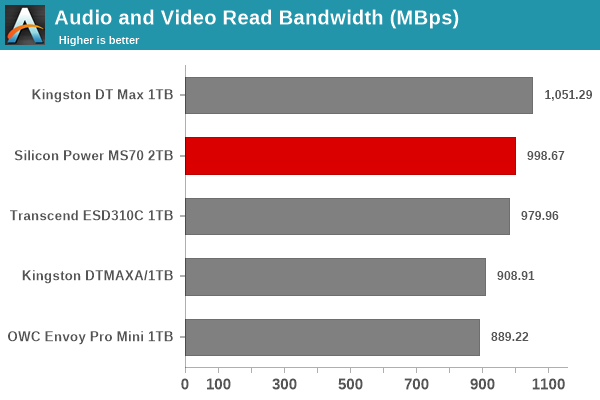
The higher capacity of the MS70 relative to the other UFDs in the comparison list gives it an edge across all of the above workloads. Interestingly, the advantage is not consistent across the different components, and the disk-to-disk segments that happen towards the end of the routine seems to suffer. This indicates the possibility of thermal throttling. Power users may want to dig deeper to understand the limits of each device. To address this concern, we also instrumented our evaluation scheme for determining performance consistency.
Performance Consistency
Aspects influencing the performance consistency include SLC caching and thermal throttling / firmware caps on access rates to avoid overheating. This is important for power users, as the last thing that they want to see when copying over 100s of GB of data is the transfer rate going down to USB 2.0 speeds.
In addition to tracking the instantaneous read and write speeds of the DAS when processing the AnandTech DAS Suite, the temperature of the drive was also recorded. In earlier reviews, we used to track the temperature all through. However, we have observed that SMART read-outs for the temperature in NVMe SSDs using USB 3.2 Gen 2 bridge chips end up negatively affecting the actual transfer rates. To avoid this problem, we have restricted ourselves to recording the temperature only during the idling intervals. The graphs below present the recorded data.
| AnandTech DAS Suite - Performance Consistency | |
| TOP: | BOTTOM: |
 |
|
The first three sets of writes and reads correspond to the AV suite. A small gap (for the transfer of the video suite from the internal SSD to the RAM drive) is followed by three sets for the Home suite. Another small RAM-drive transfer gap is followed by three sets for the Blu-ray folder. This is followed up with the large-sized ISO files set. Finally, we have the single disk-to-disk transfer set. These graphs bring out the temporal aspect associated with the numbers in the preceding section's graphs. The Silicon Power MS70 is able to sustain higher write speeds for a longer duration in the initial benchmark components, though the temperature numbers are higher than the OWC Envoy Pro Mini's. However, the profile in the disk-to-disk transfer set is remarkably similar for both Phison drives after the SLC cache runs out. Overall, the use of newer SK hynix flash enables the Silicon Power MS70 to deliver an overall better performance profile compared to the other drives in the list. While thermal throttling is a concern (the MS70 reported 78C at the end of the disk-to-disk write segment, compared to the OWC Envoy Pro Mini's 72C), it is probably not a deal-breaker given the product's price point.
PCMark 10 Storage Bench - Real-World Access Traces
There are a number of storage benchmarks that can subject a device to artificial access traces by varying the mix of reads and writes, the access block sizes, and the queue depth / number of outstanding data requests. We saw results from two popular ones - ATTO, and CrystalDiskMark - in a previous section. More serious benchmarks, however, actually replicate access traces from real-world workloads to determine the suitability of a particular device for a particular workload. Real-world access traces may be used for simulating the behavior of computing activities that are limited by storage performance. Examples include booting an operating system or loading a particular game from the disk.
PCMark 10's storage bench (introduced in v2.1.2153) includes four storage benchmarks that use relevant real-world traces from popular applications and common tasks to fully test the performance of the latest modern drives:
- The Full System Drive Benchmark uses a wide-ranging set of real-world traces from popular applications and common tasks to fully test the performance of the fastest modern drives. It involves a total of 204 GB of write traffic.
- The Quick System Drive Benchmark is a shorter test with a smaller set of less demanding real-world traces. It subjects the device to 23 GB of writes.
- The Data Drive Benchmark is designed to test drives that are used for storing files rather than applications. These typically include NAS drives, USB sticks, memory cards, and other external storage devices. The device is subjected to 15 GB of writes.
- The Drive Performance Consistency Test is a long-running and extremely demanding test with a heavy, continuous load for expert users. In-depth reporting shows how the performance of the drive varies under different conditions. This writes more than 23 TB of data to the drive.
Despite the data drive benchmark appearing most suitable for testing direct-attached storage, we opt to run the full system drive benchmark as part of our evaluation flow. Many of us use portable flash drives as boot drives and storage for Steam games. These types of use-cases are addressed only in the full system drive benchmark.
The Full System Drive Benchmark comprises of 23 different traces. For the purpose of presenting results, we classify them under five different categories:
- Boot: Replay of storage access trace recorded while booting Windows 10
- Creative: Replay of storage access traces recorded during the start up and usage of Adobe applications such as Acrobat, After Effects, Illustrator, Premiere Pro, Lightroom, and Photoshop.
- Office: Replay of storage access traces recorded during the usage of Microsoft Office applications such as Excel and Powerpoint.
- Gaming: Replay of storage access traces recorded during the start up of games such as Battlefield V, Call of Duty Black Ops 4, and Overwatch.
- File Transfers: Replay of storage access traces (Write-Only, Read-Write, and Read-Only) recorded during the transfer of data such as ISOs and photographs.
PCMark 10 also generates an overall score, bandwidth, and average latency number for quick comparison of different drives. The sub-sections in the rest of the page reference the access traces specified in the PCMark 10 Technical Guide.
Booting Windows 10
The read-write bandwidth recorded for each drive in the boo access trace is presented below.
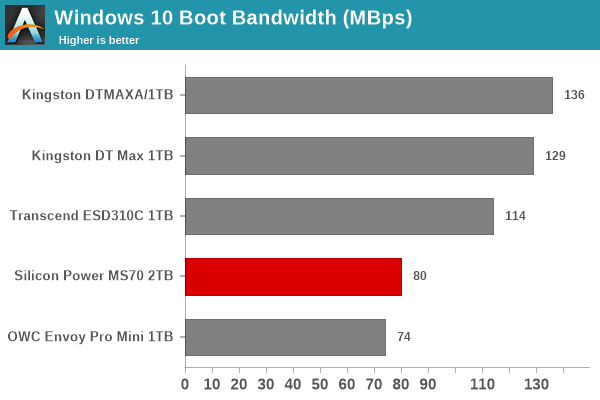
Both Phison drives perform similarly for the OS boot workload, with a slight edge for the MS70. The units based on the Silicon Motion controller deliver much better results and make up the top half of the pack.
Creative Workloads
The read-write bandwidth recorded for each drive in the sacr, saft, sill, spre, slig, sps, aft, exc, ill, ind, psh, and psl access traces are presented below.
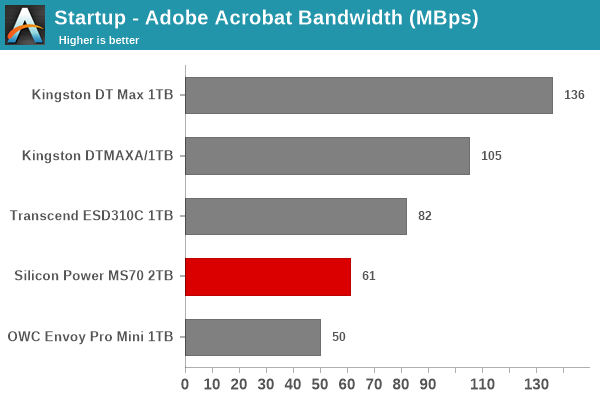
The Silicon Motion controller-based UFDs deliver much better numbers for the creative application workloads compared to the Phison units. The only exception is the Adobe Photoshop Heavy trace where the capacity point of the MS70 helps in trumping the rest of the competition. In other traces, we see the MS70 consistently in the penultimate place, just ahead of the OWC Envoy Pro Mini.
Office Workloads
The read-write bandwidth recorded for each drive in the exc and pow access traces are presented below.
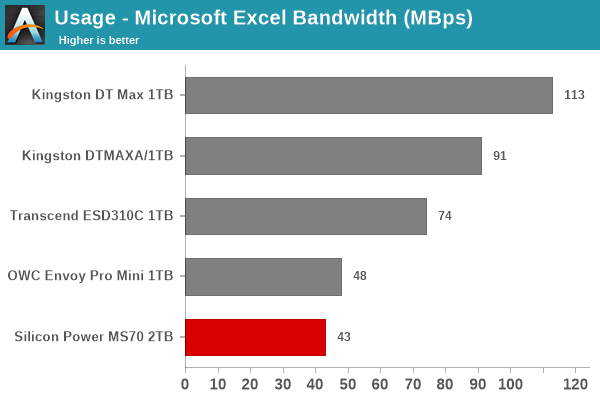
The observations made in the creative applications section hold true for the office workloads as well, with the Phison units making up the bottom half of the pack.
Gaming Workloads
The read-write bandwidth recorded for each drive in the bf, cod, and ow access traces are presented below.
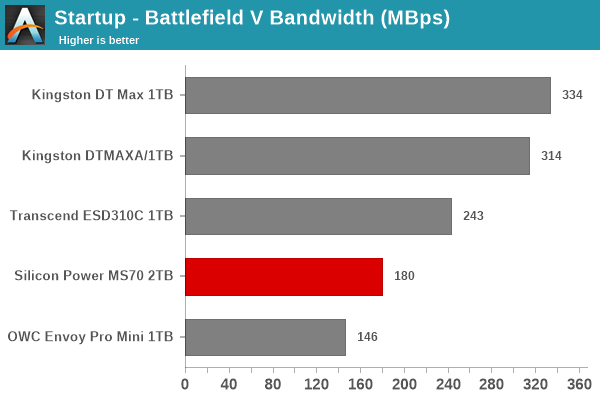
The results in the read-heavy gaming scenarios are no different, as these types of real-world application scenarios tend to trip up the Phison units. The firmare in those UFDs seem to be tuned for simple file transfer workloads, and doesn't seem to be entirely suited for application access traces.
Files Transfer Workloads
The read-write bandwidth recorded for each drive in the cp1, cp2, cp3, cps1, cps2, and cps3 access traces are presented below.

The Phison units manage to make a move up the chain in the file transfer workloads, as the firmware seems to be optimized for those types of scenarios.
Overall Scores
PCMark 10 reports an overall score based on the observed bandwidth and access times for the full workload set. The score, bandwidth, and average access latency for each of the drives are presented below.
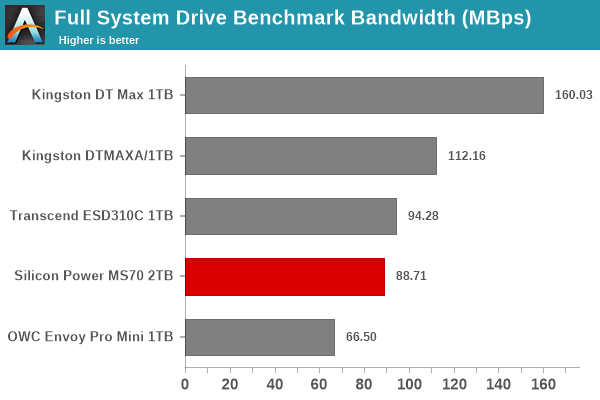
Based on the results observed in various individual traces, it comes as no surprise to see the MS70 placed second from last in the overall metrics. Only the Files Transfers workload component bears relevance to Silicon Power's focus with the MS70, and the numbers in that don't contribute enough to prevent it from dropping to the bottom half of the pack.










28 Comments
View All Comments
artifex - Thursday, December 21, 2023 - link
5 year warranty seems pretty aggressive, too.kaidenshi - Thursday, December 21, 2023 - link
Given my past experience with Silicon Power SSDs, you're going to need it. Maybe this uses a better controller or more reliable flash chips, but every single SP SATA SSD I've owned has died within a year. I had one DOA that Amazon thankfully replaced, but the others died long after the return window and SP would not stand behind them.As compelling as a $100 2TB thumb drive with good performance is, I'll pass on this brand.
deil - Friday, December 22, 2023 - link
I had 3, 2 of them live to this day, with about 5 years each and one died under 3 months, and was replaced easily.I have 60TB on A55, 512, and I have no way to check the other one, right now. They were fairly slow, and I did not use them for anything important.
I am not sure if you are to harsh on them or not, but I don't think they are as bad as you say.
They are fair for their price. Usually something like 10-15% cheaper if I remember.
artifex - Saturday, December 23, 2023 - link
I'd never bought SP before but had been thinking about it. Thanks for the warning.ciparis - Thursday, December 21, 2023 - link
Please call me when someone finally ships a device that is not USB-A native.Techie4Us - Thursday, December 21, 2023 - link
2nd that ! I'm so tired of seeing these so-called "new" devices, only to see the pics & learn that they are built with the old style connectors...Gimme USB-C everywhere, or gimme death !
mark625 - Tuesday, January 2, 2024 - link
This will happen when PCs start coming with 8-10 USB-C ports and only 2 or 4 USB-A ports. In other words, another 10 years or so.TheinsanegamerN - Wednesday, January 3, 2024 - link
Just buy dongles.kylothow - Friday, December 22, 2023 - link
People that don't exclusively use toy computers still mostly rely on the more affirmed and retro compatible standard.aebiv - Sunday, December 24, 2023 - link
I’m sorry you’re trapped in the past.